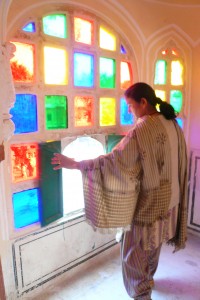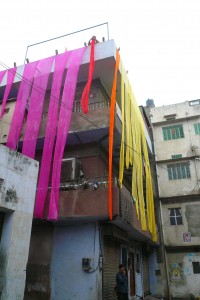 At first, I tried to resist the seduction. I felt that there was something shameful, whorish even, in tourists lusting after color, pointing their cameras at a retreating pink sari, or a flash of red turbans. Yet over and over again I swiveled toward the colors, camera in hand, as if magnetized. I was in northwest India for ten days, reporting a story for the New York Times about traditional arts in Rajasthan—a region renowned for its riotous visuals, and beset, as throughout India, with crippling poverty.
At first, I tried to resist the seduction. I felt that there was something shameful, whorish even, in tourists lusting after color, pointing their cameras at a retreating pink sari, or a flash of red turbans. Yet over and over again I swiveled toward the colors, camera in hand, as if magnetized. I was in northwest India for ten days, reporting a story for the New York Times about traditional arts in Rajasthan—a region renowned for its riotous visuals, and beset, as throughout India, with crippling poverty.
In Jaipur, Rajasthan’s salmon-hued capital, teenage mothers shoved their dusty babies against my taxi window, rapping their knuckles on the car and holding their fingertips up to their mouths to signal hunger. Ghostly men huddled by oil drum fires in the middle of the night, their skeletal frames wrapped in ratty wool blankets.
As a first-timer in India, I struggled to square the jaw-dropping beauty with the degradation and despair. I recognized what role color played for me: it was a balm for my eyes, a reassuring bit of loveliness among all the terrible, unfathomable things I saw. I was on vigilant guard for that dangerous, numbing reaction: they may be poor, but they are beautiful. I cringed at some of the other Westerners in my daily view: people who pranced around in peasant skirts and jangly jewelry, their eyes perpetually wide, soaking up the country’s life force in a way that felt, to me, parasitical. I really wanted to avoid being a tourist cliché. And yet I longed to find a point of connection. Within a day of my arrival, I’d worked myself into a frothy self-consciousness.
Of course, traveling in chaotic India quickly reminds you of everything you can’t control, including your understanding of a place, or your uneasy sense of dislocation. And soon I began to treasure the beauty that sidled alongside the occasional horror. OK, there was an old man jerking off in broad daylight on a park bench… but look over here: an embellished elephant with neon swirls chalked onto its butt! “This is India, ma’am—everything is possible,” a taxi driver counseled me one afternoon, as he swerved around a drunk rickshaw driver who sat slumped in the middle of a busy road. I adopted it as my travel mantra.

“Color has a lot of meaning in Rajasthan,” explained the historian Rima Hooja one afternoon in Jaipur, swiftly disabusing me of my color-induced anxieties as we sipped cups of chai at a block-printing museum. “Bright colors—red, yellow, pink, orange—are auspicious, and the meaning of color shifts from community to community. Traditionally, a Rajput widow wears blue; others wear white. The way people dress reveals their background.” To my eye, though, the women working on a nearby construction site looked like queens, swathed in layers of intricately patterned fabrics and kitted out with ankle bracelets and piles of bangles, even as they carried concrete rubble in metal bowls balanced atop their heads. They seemed to exult in their own beauty, their heads held high and their bling glimmering through the dust.
In the end, I let it all in: the color, the beauty, the contradictions. It began the morning of Kite-Flying Day, a state holiday in Rajasthan. I awoke to the sound of a low-pitched, citywide roar, and stepped onto the balcony of my guestroom to check it out. A young boy frolicked on a nearby rooftop, flying a kite in his underpants. Beyond him, sprouting from nearly every rooftop, were legions of women and men and children tugging on strings, heads tipped back to watch the sky. It was as if the entire city had succumbed to a kite-flying epidemic. The air filled with laughter, Punjabi pop music, and the squawks of indignant birds, who seemed supremely pissed-off to be sharing airspace with a tangle of gaudy paper kites.
Later that morning I met up with Vinod Joshi, a social anthropologist who helps run the Jaipur Virasat Foundation, a nonprofit organization dedicated to protecting the city’s cultural heritage, and a key focus of my article Vinod, a gentle, excitable man in a sweater vest, had promised to show me the “real Jaipur,” which he claimed lurked well off the beaten tourist track—away from the pastel City Palace, or the honeycombed Tower of the Winds—in the back lanes of the old walled city. “There’s so much wealth scattered in the small streets,” he said, as he steered me through a labyrinth of alleys, past goats in stretched-out sweaters, giant pigs bullying piles of trash, and row after row of bustling workshops, each dedicated to its particular local craft.

Everyone seemed excited to see Vinod; they beamed as we approached, inviting us in for tea and snacks. At a gem-polishers’ workshop, two men in plaid shirts sat cross-legged in front of whirring machines, shaping and faceting gems for Tiffany and Bulgari, literally a world away. A few blocks over, a barefoot mustachioed man sat on the stoop of his dilapidated house, hammering a flat brass pancake into a wide bowl, which he held in place with his toes.
We heard the silver foil makers before we saw them. They hammered for three hours nonstop, Vinod explained, their blows eventually thinning the tiny squares of silver into an airy, almost microscopic skin. Almost a decade earlier, I’d used silver leaf in an art class in college, and wondered at its fragility—you had to apply it with tweezers, and it was prone to floating away with the slightest breeze. But now I realized, with a start, that I’d never considered where it came from, or how it was made. That it was a product of human labor seemed almost impossible to comprehend, even as I watched the men go at it. Soon the foil would be applied to the city’s famous miniature paintings, and crumbled into Ayurvedic medicine and tinctures. One of the workers handed me a wispy piece of silver leaf. Vinod motioned for me to eat it. It disappeared on my tongue like a metallic moth wing.

A few blocks over, two men crouched over a metal tub, swishing skeins of ‘auspicious’ thread in a tub of turmeric yellow dye; later, they’d be used in religious rituals and ceremonies.
 Throughout the neighborhood, drainage ditches flowed with brightly colored water, runoff from the dye process. As we passed a concrete apartment building, three women waved from the rooftop, then unrolled bolts of freshly dyed silk to air dry. The yellow and pink and orange strips flapped alongside the building like banners.
Throughout the neighborhood, drainage ditches flowed with brightly colored water, runoff from the dye process. As we passed a concrete apartment building, three women waved from the rooftop, then unrolled bolts of freshly dyed silk to air dry. The yellow and pink and orange strips flapped alongside the building like banners.
I grinned as I watched them stream down. They felt, absurdly, like a welcome.
